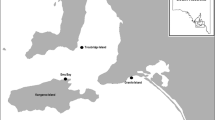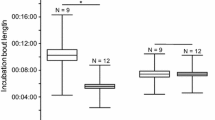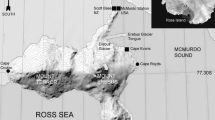Abstract
Lack of parental experience or differences in reproductive effort may lead to variation in nest defence behaviour among individuals in a prey population. In this experimental study, we analysed nest defence behaviour using a model of an American mink, Mustela vison, a non-native predator, at colonies of arctic terns, Sterna paradisaea, in two large areas where mink had been removed and two comparable control areas with mink in the south-western archipelago of Finland, Baltic Sea, in June 2000. Furthermore, we recorded breeding success of arctic terns in the same four areas during 1998–2001. Arctic terns took higher risks in nest defence in control areas and in a short-term (mink-free for 2 years) removal area than in the long-term (mink-free for 8 years) removal area. Thus, colonies with recent experience of mink were more active in defending their offspring. The breeding success of arctic terns was significantly higher in mink-removal areas than in control areas. We conclude that arctic terns modify their nest defence behaviour in the presence of mink. However, they cannot defend their nests sufficiently against this mainly nocturnal predator, since their breeding success is reduced in areas where mink are present.



Similar content being viewed by others
References
Aars J, Lambin X, Denny R, Griffin AC (2001) Water vole in the Scottish uplands: distribution patterns of disturbed and pristine populations ahead and behind the American mink invasion front. Anim Conserv 4:187–194
Allainé D (1991) The effects of colony size and breeding stage on colony defense pattern in the black-headed gull. Acta Oecol 12:385–396
Andersson Å (1992) Development of waterbird populations in the Bullerö archipelago off Stockholm after colonization by Mink (in Swedish with English summary). Ornis Svecica 2:107–118
Arroyo B, Mougeot F, Bretagnolle V (2001) Colonial breeding and nest defence in Montagu’s harrier (Circus pygargus). Behav Ecol Sociobiol 50:109–115
Banks PB (1998) Responses of Australian bush rats, Rattus fusciceps, to the odor of introduced Vulpes vulpes. J Mammal 79:1260–1264
Banks PB, Norrdahl K, Nordström M, Korpimäki E (2004) Dynamic impacts of feral mink predation on vole metapopulations in the outer archipelago of the Baltic Sea. Oikos (in press)
Beck PH, Finck P (1985) The influence of weather and food situation on the breeding success of common terns (Sterna hirundo). J Ornithol 126:393–404
Berger J, Swenson JE, Persson I-L (2001) Recolonizing carnivores and naïve prey: conservation lessons from pleistocene extinctions. Science 291:1036–1039
Bunin JS, Boates JS (1994) Effects of nesting location on breeding success of Arctic terns on Machias Seal Island. Can J Zool 72:1841–1847
Burger J (1982) The role of breeding success on colony-site selection and abandonment in black skimmers (Rhynochops niger). Auk 99:109–115
Burness GP, Morris RD (1993) Direct and indirect consequences of mink presence in a common tern colony. Condor 95:708–711
Clode D, Macdonald DW (2002) Invasive predators and the conservation of island birds: the case of American mink Mustela vison and terns Sterna spp. in the Western Isles, Scotland. Bird Study 49:118–123
Clode D, Birks JDS, Macdonald DW (2000) The influence of risk and vulnerability on predator mobbing by terns (Sterna spp.) and gulls (Larus spp.). J Zool 252:53–59
Clutton-Brock TH (1991) The evolution of parental care. Princeton University Press, New Jersey
Craik JCA (1997) Long-term effects of North American Mink Mustela vison on seabirds in western Scotland. Bird Study 44:303–309
Craik JCA (2000a) Breeding success of common gulls Larus canus in west Scotland II. Comparisons between colonies. Atl Seabirds 2:1–12
Craik JCA (2000b) A simple and rapid method of estimating gull productivity. Bird Study 47:113–116
Cramp S (ed) (1985) Handbook of the birds of Europe, the Middle East, and North Africa, vol 4. Terns to woodpeckers. Oxford University Press, Oxford
Curio E (1983) Why do young birds reproduce less well? Ibis 125:400–404
Dale S, Gustavsen R, Slagsvold T (1996) Risk taking during parental care: a test of three hypotheses applied to the pied flycatcher. Behav Ecol Sociobiol 39:31–42
Desrochers A (1992) Age-related differences in reproduction by european blackbirds: restraint or constraint? Ecology 73:1128–1131
Dunstone N, Birks JDS (1987) The feeding ecology of mink (Mustela vison) in coastal habitat. J Zool 212:69–83
Ferreras P, Macdonald DW (1999) The impact of American mink Mustela vison on water birds in the upper Thames. J Appl Ecol 36:701–708
Hakkarainen H, Korpimäki E (1994) Nest defence of Tengmalm’s owls reflects offspring survival prospects under fluctuating food conditions. Anim Behav 48: 843–849
Hario M (2002) Mink predation on black guillemots at Söderskär in 1994–1999 (in Finnish with English summary). Suomen Riista 48:18–26
Hunter RA, Morris RD (1976) Nocturnal predation by a black-crowned night-heron at a common tern colony. Auk 93:629–633
Kauhala K (1996) Distributional history of the American mink (Mustela vison) in Finland with special reference to the trends in otter (Lutra lutra) populations. Ann Zool Fenn 33 283–291
Kilpi M (1995) Breeding success, predation and local dynamics of colonial common gulls Larus canus. Ann Zool Fenn 32: 175–182
Laaksonen T, Korpimäki E, Hakkarainen H (2002) Interactive effects of parental age and environmental variation on the breeding performance of Tengmalm’s owls. J Anim Ecol 71:23–31
Lambrechts MM, Prieur B, Caizergues A, Dehorter O, Galan M-J, Perret P (2000) Risk-taking restraints in a bird with reduced egg-hatching success. Proc R Soc Lond B 267:333–338
Lemmetyinen R (1971) Nest defence behaviour of common and arctic terns and its effects on the success achieved by predators. Ornis Fenn 48:13–24
Lemmetyinen R (1972) Nest defence behaviour in the arctic tern Sterna paradisaea towards stuffed nest predators on Spitsbergen. Rep Kevo Subarct 9:28–31
Lima SL, Dill LM (1990) Behavioral decisions made under the risk of predation: a review and a prospectus. Can J Zool 68:619–640
Littell RC, Milliken GA, Stroup WW, Wolfinger RD (1996) SAS system for mixed models. SAS Institute, Cary, NC
Martin P, Bateson P (1986) Measuring behaviour: an introductory guide. Cambridge University Press, Cambridge
Montgomerie RD, Weatherhead PJ (1988) Risks and rewards of nest defence by parent birds. Q Rev Biol 63:167–187
Newton I (1998) Population limitation in birds. Academic Press, London
Niemimaa J, Pokki J (1990) Food habits of the mink in the outer archipelago of the Gulf of Finland (in Finnish with English summary). Suomen Riista 36:18–30
Nisbet ICT, Welton MJ (1984) Seasonal variations in breeding success of common terns: consequences of predation. Condor 86:53–60
Nordström M, Högmander J, Nummelin J, Laine J, Laanetu N, Korpimäki E (2002) Variable responses of waterfowl breeding populations to long-term removal of introduced American mink. Ecography 25:385–394
Nordström M, Högmander J, Nummelin J, Laine J, Laanetu N, Korpimäki E (2003) Effects of feral mink removal on seabirds, waders and passerines on small islands in the Baltic Sea. Biol Conserv 109:359–368
Numers M von (1995) Distribution, numbers and ecological gradients of birds breeding on small islands in the Archipelago Sea, SW Finland. Acta Zool Fenn 197:1–127
Owen M, Norderhaug M (1977) Population dynamics of Barnacle geese Branta leucopsis breeding in Svalbard, 1948–1976. Ornis Scand 8:161–174
Redondo T (1989) Avian nest defence: theoretical models and evidence. Behaviour 111:161–195
Seto NWH, Conant S (1996) The effects of rat (Rattus rattus) predation on the reproductive success of the bonin petrel (Pterodroma hypoleuca) on Midway Atoll. Colon Waterbirds 19:171–185
Short J, Kinnear JE, Robley A (2002) Surplus killing by introduced predators in Australia—evidence for ineffective anti-predator adaptations in native prey species? Biol Conserv 103:283–301
Sidorovich VE, Kruuk H, Macdonald DW (1999) Body size, and interactions between European and American mink (Mustela lutreola and M. vison) in Eastern Europe. J Zool 248:521–527
Svensson L (1992) Identification guide to European passerines. Fingraf, Södertälje, Sweden
Tolonen P, Korpimäki E (1995) Parental effort of kestrels (Falco tinnunculus) in nest defence: effects of laying time, brood size, and varying survival prospects of offspring. Behav Ecol 6:435–441
Trivers RL (1972) Parental investment and sexual selection. In: Campbell B (ed) Sexual selection and the descent of man. Aldine, Chicago, pp 136–179
Veen T, Richardson DS, Blaakmeer K, Komdeur J (2000) Experimental evidence for innate predator recognition in the Seychelles warbler. Proc R Soc Lond B Biol 267:2253–2258
Walsh PM, Halley DJ, Harris MP, del Nevo A, Sim IMW, Tasker ML (1995) Seabird monitoring handbook for Britain and Ireland. JNCC, RSBP, ITE, Seabird Group
Whittam RM, Leonard ML (1999) Predation and breeding success in roseate terns (Sterna dougallii). Can J Zool 77:851–856
Wiebe KL, Martin K (1998) Age-specific patterns of reproduction in white-tailed and willow ptarmigan Lagopus leucurus and L. lagopus. Ibis 140:14–24
Williams GC (1966) Adaption and natural selection. Princeton University Press, Princeton, NJ
Woodroffe G, Lawton J, Davidson W (1990) The impact of feral mink Mustela vison on water voles Arvicola terrestris in the North Yorkshire Moors National Park. Biol Conserv 51:49–62
Acknowledgements
M.N. was financially supported by the Maj and Tor Nessling foundation. Mink removal and bird census work were financially supported by the Metsähallitus Forest and Park Services and the EU Commission Interreg IIa program, and nest defence trials were supported by the Academy of Finland (grant nos. 63525, 64542, 69014, 71110, 74131, 80696 and 202013 to E.K.). Mink removal was conducted by N. Laanetu and J. Nummelin, with assistance from J. Andersson, Ö. Mattsson, and B. and I. Willström. J. Högmander, M. Lappalainen, R. Lindroos, M. Miettinen, L. Nikkinen, K. Rainio, and W. Velmala assisted in the field. J. Bêty, V. Bretagnolle, T. Klemola, M. Mönkkönen, K. Norrdahl, and two anonymous referees gave valuable comments on the manuscript. Permission to work in restricted areas was given by the Metsähallitus Forest and Park Services, and a licence to ring and measure wild birds was held by the zoological museum at the University of Helsinki, Finland. All procedures in this study comply with the national laws and regulations of Finland.
Author information
Authors and Affiliations
Corresponding author
Additional information
Communicated by J. Graves
Rights and permissions
About this article
Cite this article
Nordström, M., Laine, J., Ahola, M. et al. Reduced nest defence intensity and improved breeding success in terns as responses to removal of non-native American mink. Behav Ecol Sociobiol 55, 454–460 (2004). https://doi.org/10.1007/s00265-003-0731-z
Received:
Revised:
Accepted:
Published:
Issue Date:
DOI: https://doi.org/10.1007/s00265-003-0731-z




